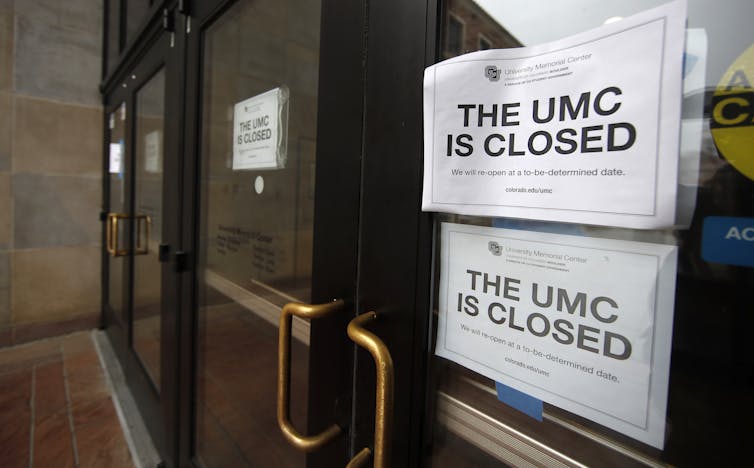
Lesley Michalegko, Arizona State University; Eric Welch, Arizona State University; Mary K. Feeney, Arizona State University, and Timothy P. Johnson, University of Illinois at Chicago
On March 6, 2020, universities across the U.S. announced systematic laboratory closures, social distancing policies and travel bans to cope with the growing coronavirus epidemic. These actions, while prudent and necessary, had immediate negative impacts on the academic enterprise of science in the U.S. and around the world.
We are a team of researchers who study the role of science and technology in society. We are also part of a collaborative, multi-university project, called SciOPS, that seeks to improve how scientists communicate with the public. As the pandemic wore on, researchers began telling us about the work stoppages, data losses and other hardships they were experiencing. We felt this was important information, so we conducted two surveys to understand how the pandemic was affecting researchers.
The pandemic’s hardships in academia have been widespread and lasting, but our analyses revealed that female and early career scientists faced more negative impacts than other groups. These differences are likely aggravating already existing disparities and potentially altering career trajectories. The negative outcomes may last well beyond the end of the pandemic.
A survey of researchers
The SciOPS team conducted its first COVID-19 survey in May 2020, with a follow-up exactly a year later in May 2021. For each, we invited faculty from a random sample of 21 U.S. research universities who work in biology, engineering and biochemistry to participate in the study, and about 300 scientists responded each time. Through a series of multiple choice and open-ended questions, the surveys asked how researchers had been affected both professionally and personally by the pandemic.

How the coronavirus disrupted science
Our first survey found that disruptions at work and home negatively affected research activities for a vast majority of the scientists who responded.
On the research side, 93% of respondents experienced university shutdowns and 88% faced lab work disruptions. Over 80% dealt with conference cancellations and travel restrictions. Some researchers also had to quickly adapt to financial issues, and this, along with other hurdles, saw many scientists delaying data collection, applying for timeline extensions or ending data collection early.
Challenges at home also affected scientists’ work. Roughly 80% of respondents said they were unable to concentrate on research activities, 72% had anxiety about contracting COVID-19 and 36% had to manage unexpected child care responsibilities.
The May 2021 survey showed that a year later, not much had changed. Responses were nearly identical: 92% of scientists reported difficulties from university closures, 89% experienced lab work disruptions and 84% had collaboration disruptions that had interrupted their research over the past year.
Issues at home were nearly the same as the year prior, too. The only major difference was that 11% percent of respondents reported coping with a family member’s illness, compared to only 3% in 2020.
Inevitably, these stressors all took a toll on researchers’ well-being. Nearly 60% indicated that their overall mental health and happiness had decreased because of the pandemic. This is higher than a Centers for Disease Control and Prevention study that found 40% of the U.S. general public were facing mental health issues in June 2021. As one researcher stated, reiterating the sentiments of many others in our study: “The mental impact of lockdown affected every researcher in my lab, including me. It was far more damaging than anything else we experienced and caused huge drop-offs in productivity.”
Younger researchers and female researchers faced more difficulties
Some scientists felt the added stress from a lack of boundaries between home and work much more acutely than others. The unexpected rises in parental child care and virtual schooling fell most heavily on female and early career faculty.
In our 2020 survey, 34% percent of female scientists reported disruptions due to unexpected child care responsibilities, compared to 21% of males. Early career faculty struggled more too. Roughly 43% of assistant professors indicated unexpected child care duties caused major disruptions to their research, 30% more than their most senior colleagues. In total, nearly 50% of both female respondents and assistant professors reported an inability to concentrate on research activities, while only 29% of male colleagues and 36% of senior colleagues reported the same.
These unequal burdens barely changed between 2020 and 2021. If anything, issues got worse for female scientists. Many reported other unanticipated complications such as management of other family members’ mental health, divorce and limited space at home.
Given the extra burdens young researchers and female researchers are facing, it’s no surprise their work suffered. Other research has shown that during the pandemic, female scientists had significantly less time to work on research. Many were not able to meet deadlines, and so they submitted fewer manuscripts compared to pre-pandemic levels.
Unsurprisingly, these impacts on productivity were even worse for women with children. Research has shown that home disruptions can cascade over time and result in delayed promotions and tenure. Even pre-COVID-19, working mothers in academia left their respective fields at much higher rates than their male colleagues, and this trend was further amplified by the pandemic.

Adapting to the new world
Undoubtedly, the pandemic has had devastating effects on academic research and those who do it. But hidden among the gloom of our surveys were a few bright spots that highlight the resilience of the scientific community.
In our 2020 survey, 37% of scientists said that they developed new research topics to pursue, and 22% developed new collaborations. Virtual meetings proved to be a valuable transition for some. As one researcher noted, “Through regular videoconference discussions, new and long-distance collaborations have been initiated and maintained between four labs in the U.S. This would have been never envisaged prior to the Zoom era.”
The pandemic highlighted existing problems within science but also offered lessons to be learned. Many in academia want to avoid deepening existing inequities in the scientific workforce, and studies have outlined ways to do this. By implementing programs such as tenure clock extensions, advocating for affordable child care and allocating funds to support early career women researchers, the scientific community could enable broader participation, capacity and production for all scientists.
Looking forward, we believe it is critically important for universities and research funders to proactively address the continuing challenges posed by the pandemic, particularly for female and early career faculty. With so much in flux, there is an opportunity to change and improve a system that wasn’t working for a lot of people prior to the pandemic.
[Get the best of The Conversation, every weekend. Sign up for our weekly newsletter.]![]()
Lesley Michalegko, Research Project Manager of Public Policy, Arizona State University; Eric Welch, Professor & Director, Center for Science, Technology & Environmental Policy Studies, Arizona State University; Mary K. Feeney, Professor and Lincoln Professor of Ethics in Public Affairs, Arizona State University, and Timothy P. Johnson, Professor Emeritus of Public Administration, University of Illinois at Chicago
This article is republished from The Conversation under a Creative Commons license. Read the original article.
The views and opinions expressed in the article are solely those of their authors, and do not necessarily reflect the opinions and beliefs of WomenInScience.com.